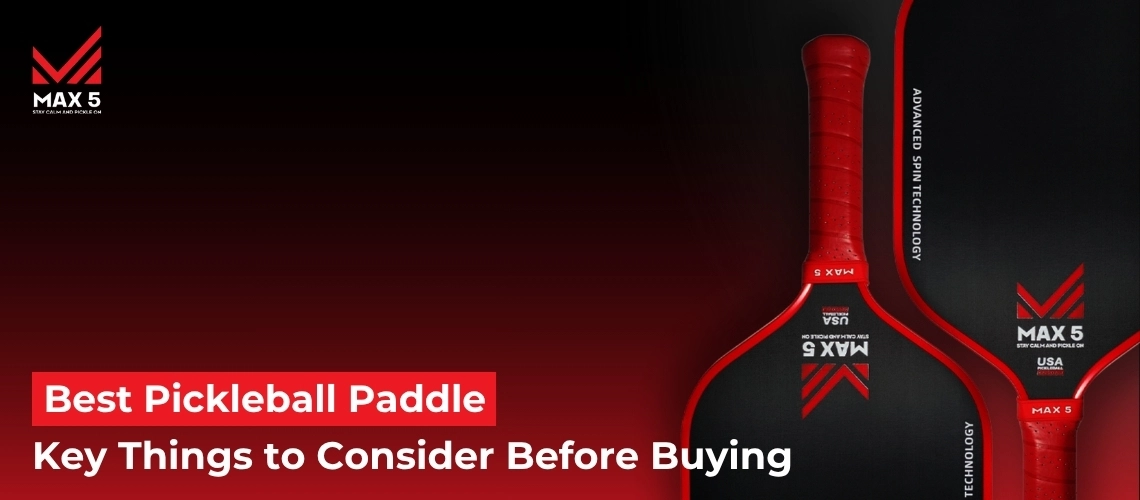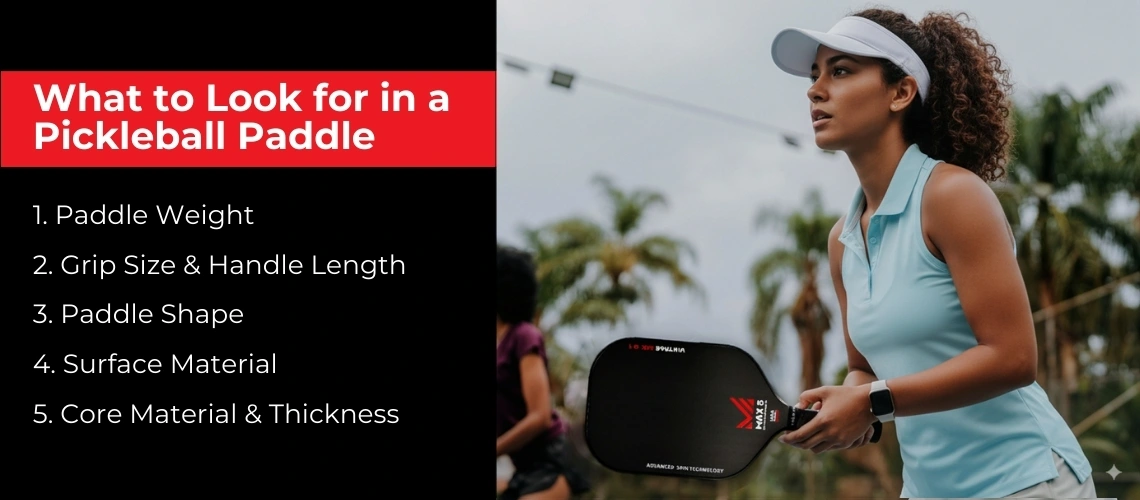
How to Pick a Pickleball Paddle – 5 Key Things to Consider
Choosing a pickleball paddle might not sound like a big deal until you hit your first mishit, feel wrist pain, or wonder why your shots aren’t going where you want them to. Whether you’re a total beginner or someone looking to level up, your paddle has a huge impact on how you play. It’s the one piece of gear you use every single shot, so picking the right one matters.
This guide will walk you through everything from paddle weight and grip size to the materials that make up the face and core. It’s not rocket science, but there is a bit of science behind picking the right paddle. By the time you’re done here, you’ll know exactly what to look for (and what to ignore).
Why the Right Paddle Makes a Big Difference
Think of your paddle like a tennis racket or a golf club; it’s your direct connection to the ball. A paddle that’s too heavy, too light, or just the wrong shape can mess with your control, power, and even lead to aches and pains over time in your shoulder.
Here’s what happens when you use the wrong paddle:
- Your shots go off-target more often.
- You get tired faster, especially in long rallies.
- You might feel strain in your wrist, elbow, or shoulder.
- You plateau quicker because your gear isn’t supporting your improvement.
But when do you find the right one? Everything clicks. You’ll feel more confident, more accurate, and just more in control. So yeah, it’s worth getting right.
What to Look for in a Pickleball Paddle
Let’s break it down. Here are the main factors to pay attention to:
1. Paddle Weight
This is one of the first things you’ll notice when you pick up a paddle and one of the most important. The weight affects your swing speed, power, and how tired your arm gets over time.
- Lightweight (under 7.3 oz): These are great for quick hands and control. You’ll move faster at the net but might struggle to put away shots with power.
- Midweight (7.3 to 8.4 oz): This is the sweet spot for most players. You get a nice mix of power and control.
- Heavyweight (8.5 oz and up): These hit hard but can be tiring, especially if you’re playing long games or don’t have strong wrists.
Quick tip: Opt for the heaviest paddle you can comfortably swing. Most players start with something midweight and adjust from there. The Vintage Max 5 0.1 is the most suitable option for you.
2. Grip Size & Handle Length
Your grip matters way more than you think. Too small, and your hand will overcompensate, possibly leading to wrist pain. Too big, and the paddle feels clunky.
- Small (4″ – 4 1/8″): Great for control, wrist action, and generating spin. Best for smaller hands.
- Standard (4 1/4″ – 4 3/8″): Works for most people. A solid middle ground.
- Thick (4 1/2″ and up): Reduces strain, better for players with large hands or grip issues.
To measure: Grab a ruler and measure from the tip of your ring finger to the middle crease of your palm. Or do the “index finger test” you should be able to slide your non-paddle hand’s index finger between your palm and grip comfortably.
Also, check the handle length. If you like using two hands on backhands, look for a paddle with a longer handle (around 5.5-6″). Shorter handles mean more paddle face, but limit your two-handed options.
3. Paddle Shape
Paddles come in different shapes. Each shape affects your reach, sweet spot, and how the paddle moves in your hand.
- Standard/Wide Body: The classic shape, great for beginners or all-around play.
- Elongated: Adds extra reach and spin. Perfect for singles players or those who like to attack from the baseline.
- Oversized: Bigger sweet spot, shorter handle. Forgiving and fun.
- Short Handle/More Face: Some players like more surface to work with which can help with dinks and blocks.
If you’re not sure, start with a standard shape. It’ll give you more forgiveness and balance while you figure things out.
4. Surface Material
This is the outer layer that makes contact with the ball. It affects how much spin, power, and control you get.
- Fiberglass (composite): Adds pop and power. Great for offensive play.
- Graphite: Light and crisp gives you precise control and touch.
- Carbon Fiber: High-end material, excellent for spin and durability. Great for advanced players, that’s why Max 5 Vintage MX-0.1 is recommended.
If you’re newer to the game, fiberglass is a fun, poppy choice. If you want more control and durability, carbon fiber is worth the upgrade.
5. Core Material & Thickness
Now we’re getting into the paddle’s “guts.” The core determines how soft or firm the paddle feels, how much it absorbs shock, and how it reacts to your swing.
Most modern paddles use a polymer honeycomb core It’s soft, quiet, and easy on the joints.
- Polymer Core: Best all-around feel. Great for control and quiet play.
- Nomex Core: Loud and firm. Good for power players.
- Aluminium Core: Lightweight and control-oriented, but less powerful.
Thickness matters too:
- Thick Core (16mm): Cushions your shots, soft feel, ideal for control players.
- Thin Core (13mm or less): Crisper feel, more power, but less forgiveness.

Try Before You Buy (Seriously)
You can read all the specs in the world, but nothing beats hitting with a paddle.
Here’s how to test one out:
- Wall bounce: Hit against a wall to feel the bounce and consistency.
- Grip test: Hold it like you would in a real match. Does it feel natural or awkward?
- Swing test: Mimic groundstrokes and dinks. Is it too heavy? Too light?
- Sweet spot: Try hitting off-centre. Does it still feel solid?
Best Paddle Picks Based on Skill Level
Beginners
- You want a forgiving paddle with a big sweet spot.
- Midweight, standard grip, composite face.
- Try: Selkirk SLK Neo
Intermediate Players
- Look for a balance of power and touch.
- Midweight, carbon or fiberglass face, 16mm core.
- Try: Max 5 Vintage MX-0.1
(carbon face, polymer core)
Advanced Players
- Dial in based on your style—whether you’re aggressive or strategic.
- Thermoformed, Toray carbon paddles with shaped handles.
- Try: CRBN 1X Power Series
Busting a Few Paddles Myths
Let’s clear the air:
Myth 1: Expensive paddles are always better.
False. If it doesn’t match your needs or style, the price tag won’t help.
Myth 2: USAPA paddles are all the same.
Wrong again. USAPA approval just means the paddle is legal for tournament play. It says nothing about how it feels or performs.
Myth 3: Wooden paddles are fine for everyone.
Unless you’re just trying out the game once, skip wood. They’re heavy, clunky, and outdated.
Before You Buy: A Quick Checklist
- Try before you commit.
- Don’t chase the brand hype, go for comfort and feel.
- Midweight is a great starting point.
- Prioritize grip fit, this helps prevent injuries.
- Ask questions, test models, and don’t rush.
Final Thoughts
At the end, the best paddle is the one that feels right for you, is Max5 Special pickleball Paddle with lots of benefits that are discussed above. If it helps you play better, enjoy the game more, and stay pain-free, that’s a win.
Once you understand paddle weight, shape, surface, and grip, you’ll be in a great position to pick something that elevates your game. And whether you’re gearing up for your first match or your hundredth, MAX 5 has a paddle that fits the way you play.
Explore MAX 5’s full line of USAPA-approved paddles and find your perfect match today.
Ready to Level Up?
Check out the latest paddle drops at MAX 5. Whether you’re hunting for spin, power, or finesse, we’ve got you covered.
Frequently Asked Questions
What weight paddle should I use?
Midweight (7.5-8.3 oz) is the most versatile for control and power.
How do I know my grip size?
Use your hand size or try the index finger test snug but not tight.
Why does paddle shape matter?
Shapes affect your sweet spot, reach, and how easily you generate spin.
Do I need a USAPA-approved paddle?
Yes if you play in official tournaments. All MAX 5 paddles are USAPA-approved.
What’s better fiberglass or carbon fiber?
Fiberglass = pop and power. Carbon = spin and control.
How long will a paddle last?
Depends on how often you play. Most last 6 months to 2 years.
What’s a good paddle for someone moving up from beginner to intermediate?
Go for something with a polymer core and carbon face like the MAX 5 Spin Pro.
